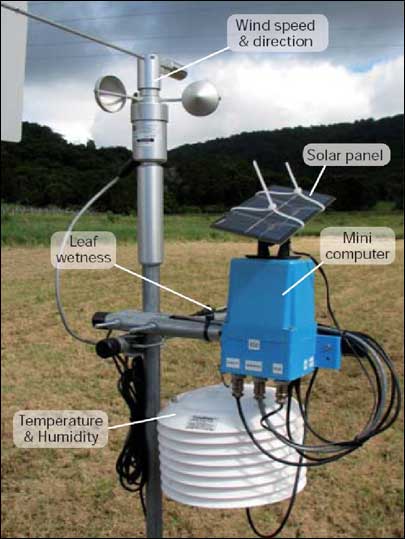Scientists in Australia have developed an innovative wireless sensor network (WSN) to monitor the environment and potentially restore endangered rainforests. The group has deployed 10 wireless solar-powered sensors in the Springbrook National Park, to measure such environmental factors as temperature, humidity, light, soil moisture and wind speed, and to relay that information to a central database located in Brisbane, Queensland.
Springbrook is part of the Gondwana Rainforest, which is included on UNESCO‘s World Heritage List for areas with outstanding heritage value. Up to 200 wireless sensors will be deployed over the next three years, including models with video and sound recorders, to provide details regarding the health of the ecosystem, fauna and flora.

Aila Keto, president of the Australian Rainforest Conservation Society (ARCS) and an adjunct professor at the University of Queensland‘s School of Agronomy and Horticulture, says the WSN could revolutionize environmental monitoring and provide a cost-effective method for protecting and restoring environmentally sensitive rainforests.
“This is a wonderful, internationally significant project,” Keto says. “The WSN will allow us to measure environmental conditions from climate change to soil moisture and water flow, and see the impact on plants and species. There is an abundance of life in the area, and we will be able to look at factors such as where species live, how they grow and what we can do to preserve them.”
The project represents a collaboration between ARCS, the Queensland Environmental Protection Authority (EPA) and the Commonwealth Scientific and Industrial Research Organisation (CSIRO), Australia’s national science research agency. The Springbrook site, chosen because of plans to restore sections of it from agricultural grassland to native rainforest vegetation, displays a wide range of environmental gradients ideal for assessing the technology’s suitability.
The project, Keto says, is particularly important because, although rainforests make up just 0.3 percent of the Australian continent, more than half of the nation’s plant and animal species rely upon the complex forests.
The EPA is determining how and where to implement the wireless sensor network for optimal results. Jonathan Hodge, the agency’s project manager, says monitoring the restoration work will provide information about biodiversity recovery on land, and deliver insight into how and why the recovery of fauna and flora occurs.
“This will result in restoration of World Heritage values on the Springbrook Plateau,” Hodge says, “and the restored land will ultimately connect sections of the national park, which have previously been split by areas of agricultural grassland. In the future, wireless sensor networks for environmental monitoring may provide a cost-effective alternative that can deliver information resulting in a greater understanding of ecological processes and the process of restoration.”
CSIRO designed the system, which utilizes the organization’s third-generation Fleck nodes to form a wireless mesh network. Each node activates its sensors and samples the environment at set intervals. Then, operating at the 915 MHz radio frequency band, the node relays the information back to the base station—either directly, or by hopping the transmission along other network nodes. The data is collated at a gateway point, located in a house on-site, and forwarded via the Internet to a central database, thanks to Telstra‘s Next G cellular communications network.
“We chose the 915 MHz band because it offers a long range of up to several hundred meters,” says Tim Wark, CSIRO’s team leader. “Even in dense foliage, the range between nodes is up to 100 meters [328 feet].”
In designing the Fleck nodes, CSIRO built its own network protocols to enable the organization to alter the network and overcome the unique problems inherent to operating in a rainforest. CSIRO plans to make the Fleck wireless sensor platform commercially available next year.
The first phase of the project is a proof of concept, Wark says, with staff members looking to identify potential problems and determine how to operate the technology effectively within a rainforest environment. The challenges include the high rainfall and humidity present at the site (which can interfere with the node’s and gateway’s RF signals), how to store the vast amounts of information generated by the project and providing power to the nodes in a cost-effective manner.
“Power is one of the biggest challenges,” Wark says, “because there are times when little sunlight is available to provide power to the compact solar panels, and there is limited energy in rechargeable batteries. So we need to be clever and minimize the time the radio is on, or limit the time the nodes sense information. We need to consider what sensors we can pull back on when we need to conserve power. This will become an even bigger challenge when we introduce acoustic and video sensors.”
Microphones will enable the scientists to identify specific birds and other animal by their calls, while video cameras will supplement the acoustic data by taking digital snapshots through motion, infrared or sound triggers. This information will allow the group to determine population numbers and trends, search for patterns regarding when the animals appear and determine which factors foster reproduction cycles.
“This project is unique in its scale and duration,” Wark says. “Other wireless sensor networks have been bigger but not operated for several years, and others have operated longer but not been as big. This truly is an ambitious project, and will produce an iconic result.”
According to Wark, the next stage is slated to begin in January 2009. This will entail the deployment of acoustic and video sensors, as well as additional nodes to gather extra information, such as light, tree diameter, sap flow, rainfall and barometric pressure.
The project, Keto says, has the potential to run for 10 or 20 years, and to provide significant information regarding the restoration of rainforests around the world. The network could be suited to a variety of applications, including agriculture, forestry, horticulture, water quality and climate change monitoring.



